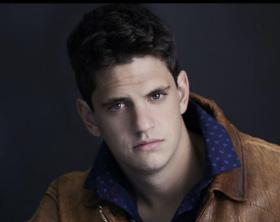







































of Christ, Schol ar ship, and service.












































of Christ, Schol ar ship, and service.



Huntington University Magazine is published by Huntington University and mailed free to Huntington alumni, faculty, staff and other friends of the University.
PRESIDENT
Dr. Sherilyn Emberton
EDITOR
Lynette Fager ’10
Director of Communication
MAGAZINE STAFF
Laura Flores
Graphic Designer
Joanne (Miller) Green ’ 93, ’10
Sports Information Director
Nicole Manges '18
Content Developer
ALUMNI ASSOCIATION
President Roger Cooley ’84
Vice President Debra Osberg ’78
Secretary Nancy Brown ’86
Member-at-Large Todd Biersack ’05
Opinions expressed herein do not necessarily reflect the policy or position of Huntington University. As a Christian university of the liberal arts, Huntington University is committed to equal opportunity and does not discriminate on the basis of race, color, sex, age, national origin or physical handicap in programs or activities.
Huntington University 2303 College Avenue
Huntington, IN 46750
Embracing a heritage of faith in Christ
4
A vision for our future from the Board of Trustees chair
7
A look back at 125 years of history
Events that marked our growth
Alumni stories from our collections
The comprehensive campaign shattered all campaign goals
|
Photos from the past year
30 |
Our new strategic plan will propel HU with success and growth
|
What, exactly, is a Forester?

As we look to 2023, we are grateful for the heritage of faith in Jesus Christ passed on to us over 125 years ago on the grounds of Central College, now the home of Huntington University. Many people have come to know His saving grace while they were students here and possibly answered a call to serve Him in their future work. God is still touching lives, as evidenced by 21 student baptisms this fall.
For that reason, we hold tight to Psalm 7:17, “I will give to the LORD the thanks due to His righteousness, and I will sing praise to the name of the LORD, the Most High,” and also to Psalm 9:1, which says, “I will give thanks to the LORD with my whole heart; I will recount all of your wonderful deeds.”

We’ve been grievously reminded this fall that we live in a broken and fallen world, where Jesus is our only hope for healing, reconciliation and restoration. With that in mind, we pray Psalm 28:7, which states, “The LORD is my strength and my shield; in Him my heart trusts, and I am helped; my heart exults, and with my song I give thanks to Him.”
We will trust in the Lord to help us embrace our 125-year calling. Hebrews 11:6 teaches us that “without faith it is impossible to please Him, for He who comes to God must believe that He is and that He is a rewarder of those who diligently seek Him.”
By submitting to our heritage of putting Christ at the center of decisions and dialogue, we trust that the influences of faith surrounding students at HU are multiplied during their time here and manifested throughout their living and learning experiences.


May we always be found as Forever Faithful. May our hearts always be joined as Forever Family. May we never forget that we are Forever Foresters!
Pray for us as we seek Him with our whole heart.
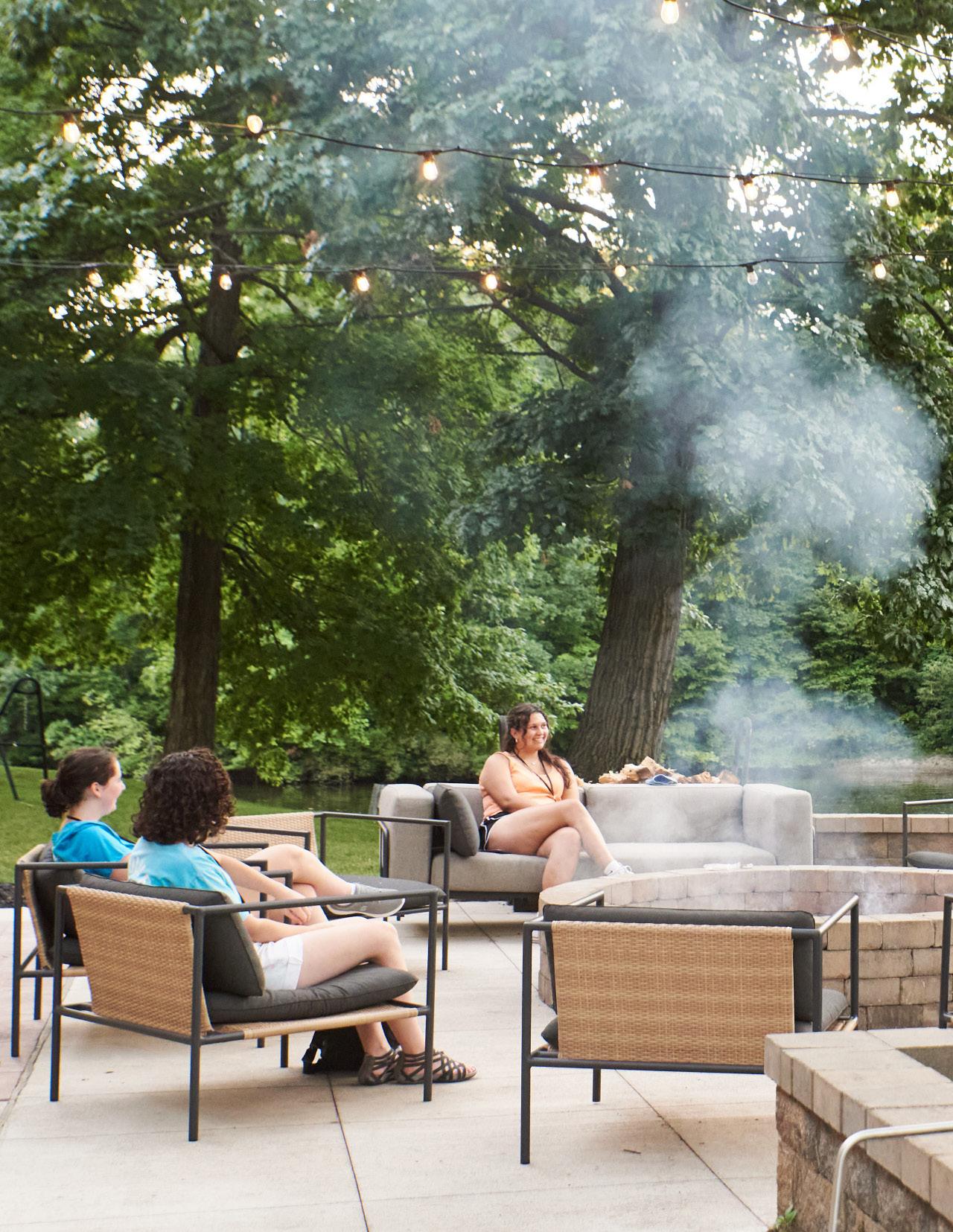
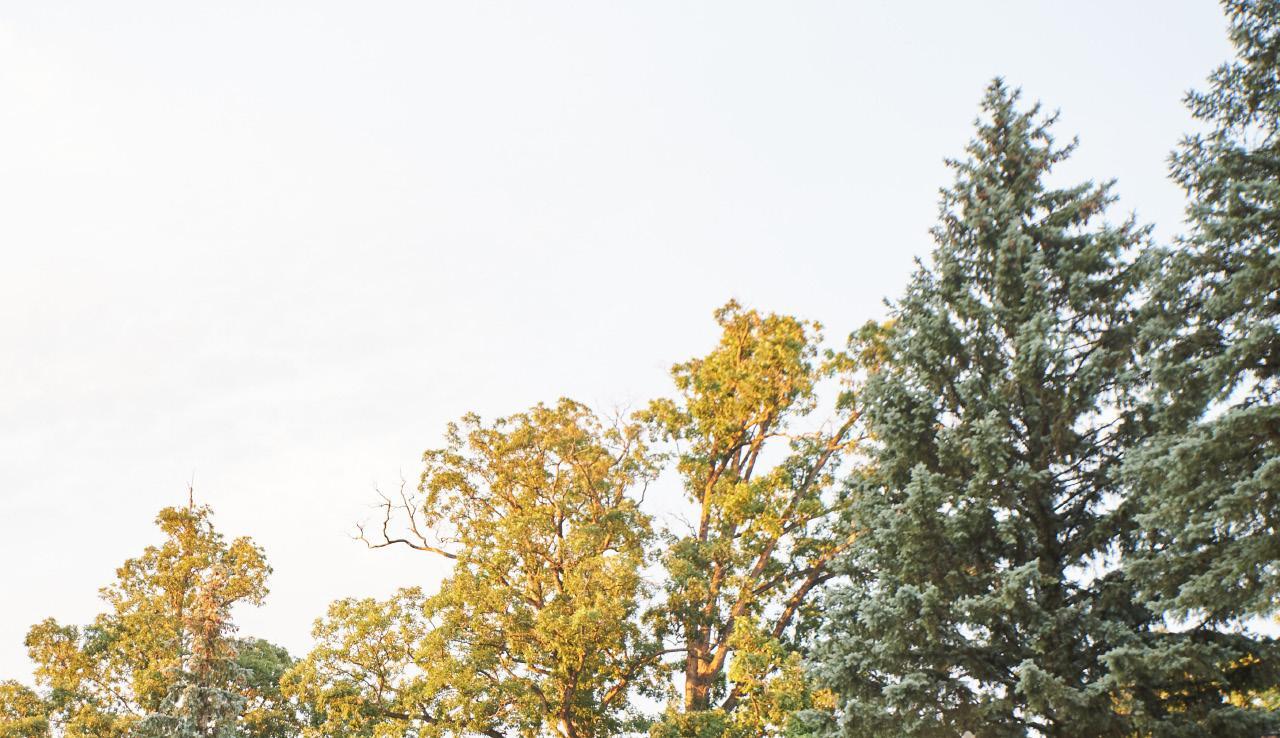
I did not attend Huntington University, but I practically grew up on HU’s home campus. My parents are both alums, and I was born and raised in Huntington. I spent many a summer’s day on campus playing tennis, catching tadpoles out of Lake Sno-Tip, hiking the paths through the woods surrounding campus and (don’t tell Dr. Emberton) swimming in the old fountain.
While my memories of Huntington University (then College) are sweet, they do not begin to compare to my vision of the future of HU. Through the efforts of so many — students, faculty, staff and Trustees — Forever Foresters, the strategic plan for the University, puts HU on a five-year path to grow as a place of worldclass education and world-changing spiritual development that will be the standard for all other Christian institutions. Following are some thoughts on my vision for HU over the next five years.

One of the aspects of HU that has always impressed me is the sense of community among the student body. The “HU Experience” is an amazing thing, at least to a not-so-
recent-graduate of a large secular university: students interacting as they go about their day, sharing a meal, a laugh, a hurt, a praise. Christ is present in the classrooms, hallways, residence halls, playing fields and coffee shop. Forever Foresters focuses on ensuring and enhancing the HU Experience for all Foresters, paying particular attention to the perspectives of commuters, students at our Fort Wayne and Arizona locations, students of color, international students and students with disabilities. I cannot forget to mention how the renovated HUB and the soon-to-be renovated PLEX will provide many additional opportunities for student interaction and enjoyment.
HU will continue to be a place of learning where students will thrive under the guidance of our world-class instructors and will be fully prepared to enter the “real world.” They may enter into business, the classroom, the church, the mission field, the medical field, the set, the home or wherever else God leads, leaving with an increased knowledge of the fundamentals and liberal arts training that will help them adapt their learning to the tasks before them.
The spiritual strength of the students today is amazing, but it will be even stronger through Forever Foresters. An emphasis on student assessment in their spiritual growth will allow the University to enhance areas of strength and bolster areas of identified weakness. Students will lean on the Center for Faith Integration as a support and a resource, and the University will celebrate the growth of the students’ faith in Jesus Christ. Another way to increase spiritual growth is to have opportunities to see God working in the world. The University will increase hands-on ministry experiences through missions trips, both domestic and abroad, and internships with churches, faithbased ministries and other areas where there is a need. I’ve always found that my heart is softened and more open to God’s direction when I’m serving. The students participating in these programs will have the same experience and, maybe, find their calling.
Despite the demographic trends showing fewer college-bound graduating seniors each year, HU enrollment will rise. This increase will result from our unabashed reliance on, and declaration of faith in, Jesus Christ; our emphasis on the HU Experience; our worldclass programs and instructors and our willingness to take bold but calculated moves into new programs, new locations and new partnerships.
There is more to my vision for the University, but in summary, I see God continuing to do amazing things at Huntington University and in the hearts and hands of her students and alumni. And through all these things, God will receive the Glory.


Selected by committee and written by Randy Neuman ’80 and Nicole Manges ’18
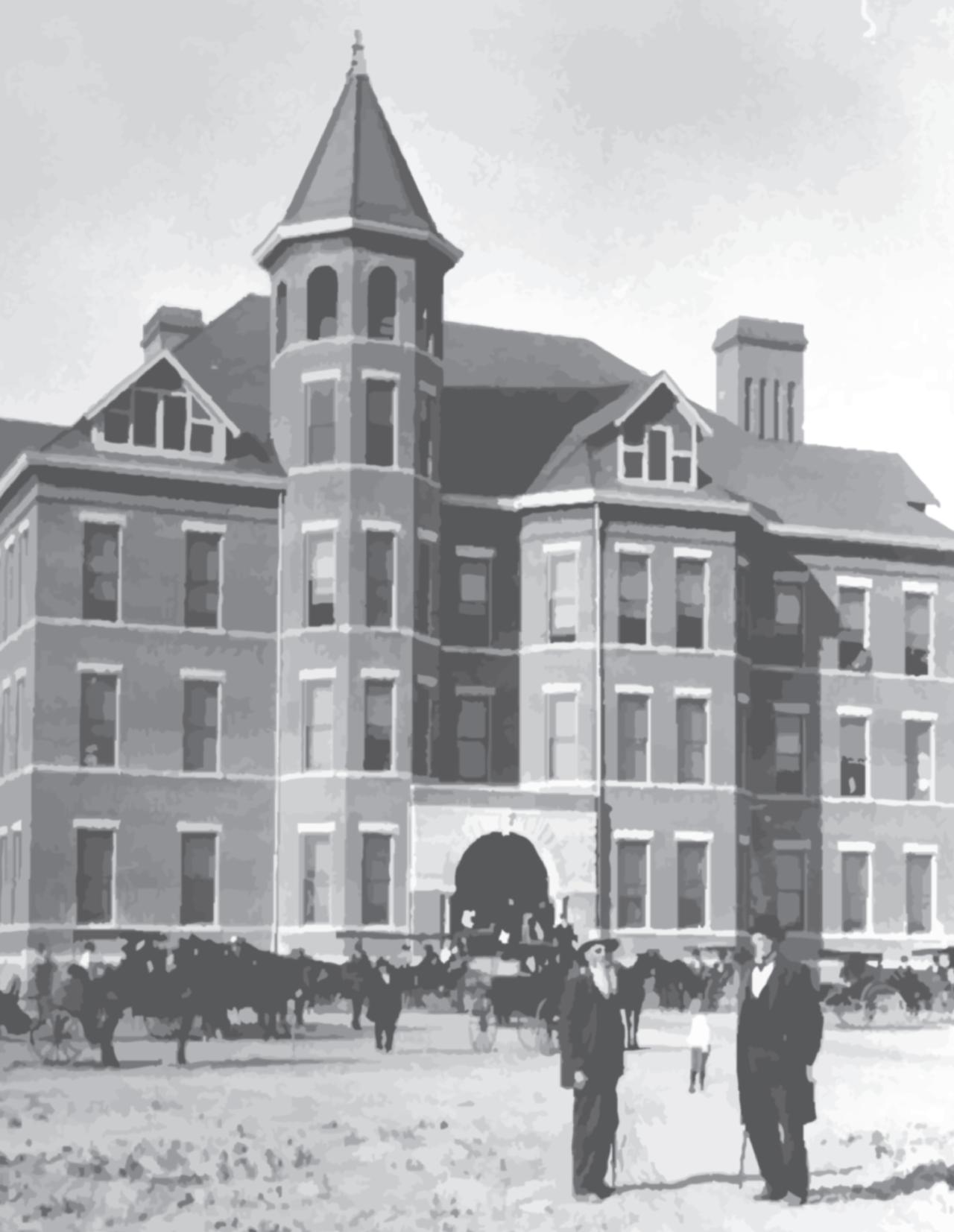
What’s in a name? These buildings, among others, are named for members of the Forester Family who helped make us who we are.


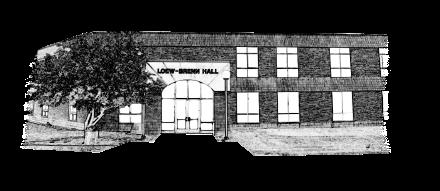
Originally the Brenn Hall of Science, Brenn Hall was built in 1963 and named for Jacob Brenn, owner of Huntington Labs and co-founder of the HU Foundation. Loew Hall was added in 1988 and named for Fred Loew (1902), professor, HU Foundation co-founder, Botanical Garden and Arboretum creator, and Huntington County’s first county agent.

Named for Mr. and Mrs. Carl Hardy, farmers and members of the UB denomination whose generosity made the hall’s construction possible.
Named for Bishop Milton Wright, who led the transition in the UB church in the late 1800s and was one of the founders of the University. The original Wright Memorial Hall was built in the late 1940s where Roush Hall is now located.
Named for J. Edward Roush (1942), a former congressman and Board of Trustees chair and longtime member.
Named for Bishop Emeritus C. Ray Miller (1951), one of the longest-serving United Brethren bishops and a former chair of the Board of Trustees.
Named for Bishop Emeritus Clyde Meadows (1925), former president of Christian Endeavor and pastor of one of the largest UB churches in Pennsylvania. He has been regarded as the most influential and respected UB leader of the twentieth century.
Named for Samuel L. Livingston, professor emeritus of theology (taught 1903-1917). The original Livingston Hall, located in front of where RichLyn Library now stands, was our first residence hall. Before that, it was Livingston’s personal residence, built by Charles Kiracofe, our first president.
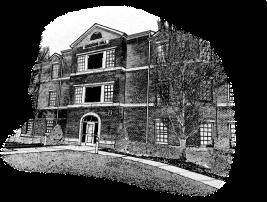
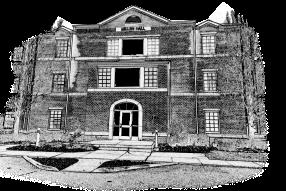


Named in honor of Don Strauss, founder of Strauss Veal Feeds and Midwest Poultry Services.
for Presidents
Becker Hall (1897)
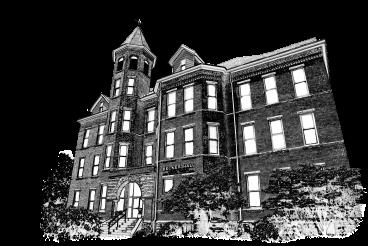
Elmer Becker (1920, 1924), ninth president
Previous names: College Hall, the Administration Building
Baker Hall (1982)
E. Dewitt Baker (1940), tenth president
Our first residence hall built around suites
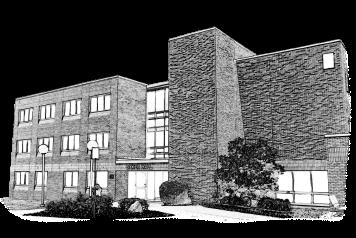
Habecker Dining Commons (1991)

Eugene Habecker, eleventh president
Named in 1991
Dowden Science Hall (2000)
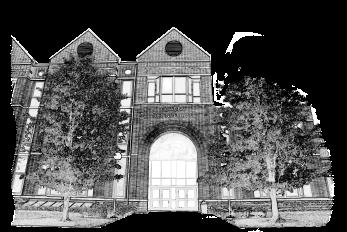
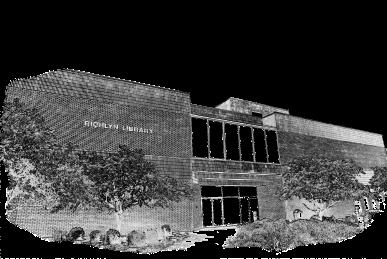
G. Blair Dowden, twelfth president, and Chris Dowden
Named in 2014
For more information about these presidents, see page 14.
Orville and Ruth Merillat were members of the UB denomination, owners of Merillat Industries and longtime University partners. The generosity of the Merillat family has led to substantial campus development.
Merillat Complex & Fieldhouse (1974)
RichLyn Library (1987)
Named for Richard and Lynette Merillat
Merillat Centre for the Arts (1990)


The Huntington Land Association promised the United Brethren Board of Education that they would provide 25 acres of land on the outskirts of Huntington, Indiana, for a college campus. They also promised to supply a fully equipped college building. By June 1, 1897, construction on this building — College Hall — was complete.
Central College’s dedication ceremony took place on September 21, 1897, on the third floor of College Hall. Approximately 1,200 to 1,500 people attended, and accounts from the time indicate that every aisle and stairway was filled to capacity as the service opened with the hymn “All Hail the Power of Jesus’ Name.” Later came Bishop Wright’s nowfamous dedication prayer.1
On September 22, the first day of classes, College Hall was the single structure on campus. In addition to its use for classrooms, lectures and chapels, it housed all administrative offices and some student housing. While the building was called “modern,” there were nineteenth century inconveniences. Heat came from a hand-fed furnace in the unfinished basement, and coal oil lamps provided light. Water came from outdoor pumps, and toilet facilities were located at the edge of the ravine in an outhouse. Nevertheless, college officials were optimistic about the incoming class of fifty students.
The Ladies Auxiliary, now called the Huntington University Auxiliary, undertook improvements to College Hall as they were needed, including new paint, wallpaper and office furniture.
1huntington.edu/FoundingHU

The oldest building on Huntington University’s home campus has had three names in the last 125 YEARS , mirroring the history of the University itself. Each name change has reflected the building’s purpose and its role in our development from a single brick building to four locations in two states.
By the mid-twentieth century, Huntington College had expanded beyond one building, though many of the halls that we now see on home campus were yet to come. With the help of the GI Bill, President Becker oversaw development after World War II. College Hall became the Administration Building to better reflect its purpose in the evolving landscape.
A name change was not all that was in store for the Ad Building during this period. By 1953, the slate roof on the tower was causing a safety hazard for pedestrians below. We removed the steeple, giving the building a squared-off look for the next 36 years. In 1989, when J. Edward Roush was serving as interim president during President Baker’s sabbatical, Roush and the Class of 1989 secured the fundraising required to restore the steeple that December. It has remained there ever since and is an integral part of our home campus logo.
Homecoming 1999 included a dedication ceremony for two new buildings — Miller Hall and Meadows Hall — and a renaming ceremony for the Ad Building. The official name change to Becker Hall posthumously honored President Becker’s legacy and drew attention back to our oldest building during a time when home campus was expanding.
Today, Becker Hall is an iconic part of Huntington University’s home campus. Named for HU’s president with the longest tenure, the oldest building on campus is a testament to our 125year journey. Although its uses (and names) have changed considerably over time, Becker Hall continues to stand tall.

From the earliest days of Central College until the mid-twentieth century, the college library had been housed in the College Hall/Administration Building. By the time President Becker took office, space was at a premium, and we were looking toward national accreditation. A new library would be part of the accreditation standards we would need to meet.
Dr. Fred Loew had fostered the idea of a library for several years and helped recruit alumni to join in the project. Construction on a building started in 1947, but by 1953 only the outside shell and ground floor were finished. We needed further funds to finish off the upper levels. Not wanting to waste the space in the meantime, students and faculty moved books and stacks into the ground floor in May 1953. The building was not fully finished and dedicated until 1959 — the longest building project in our history.
In the early days of athletics at Huntington University, the “gymnasium” was a portioned-off section of the west end of Davis Hall on the third floor of College Hall (now called Becker Hall). Davis Hall was also used for chapel, large gatherings, and music and theatre productions.
Students contributed most of the labor required to construct the first campus gymnasium in 1921. We added a tower and brick façade in 1934 using bricks from an unused building in the city that was scheduled for demolition. Located southeast of College Hall, the original gymnasium stood until
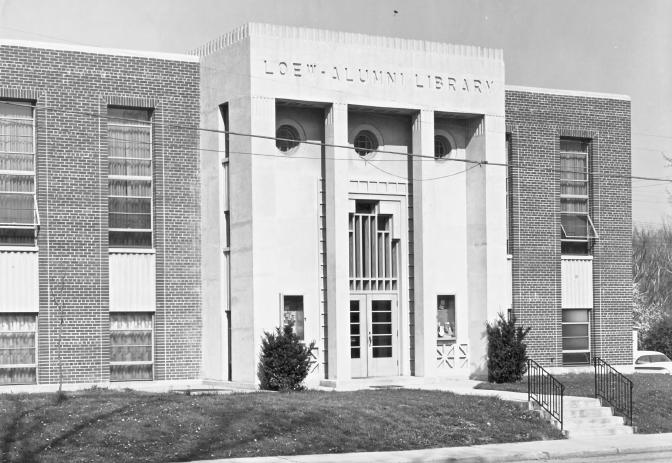
President Habecker’s Long Range Plan included the development of a new library. In 1987, RichLyn Library was ready, with more than double the floor space of the Loew-Alumni Library available.

Once again, Foresters showed up to fill the finished library, carrying books from building to building by hand. In addition to books and reference materials, RichLyn Library included a state-of-the-art information retrieval system and one of the first online catalogs ever implemented in a private Indiana college.
The Loew-Alumni Library, later renamed Administration Annex, housed numerous administrative offices and the Department of Ministry and Missions until it was razed in 2020.
1985. In its later years, the gym was home to dodge ball and kill ball games (yes, you read that right).
Since it opened in 1974, the current Merillat Complex has seen some of our best athletes pass through its doors. Many graduates recognize this space as the PERC, or Physical Education and Recreation Complex, while current students know it as the PLEX, or the Merillat Complex & Fieldhouse. The round of transformations to the PLEX that are currently underway will once again change the look and accessibility of physical education and athletics at Huntington University.
Our first president, Charles H. Kiracofe, built his home on the corner of College Avenue and Lake Street. He sold the residence to theology professor Samuel L. Livingston in 1905.
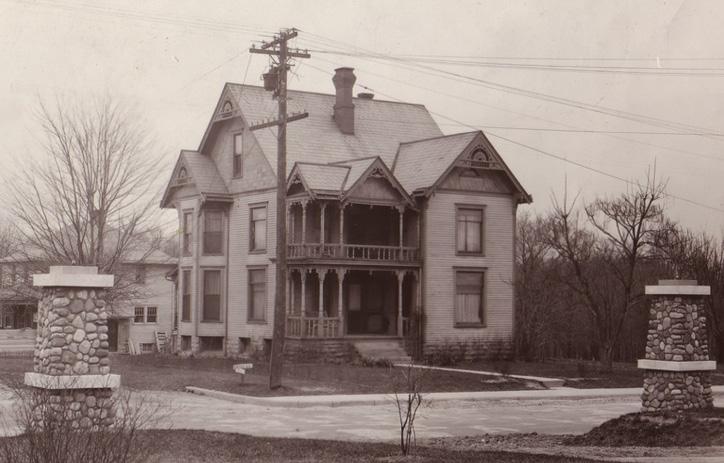
In 1916, when Livingston retired, he sold the residence to the College. For a while, the house served as the President’s residence, but President Bangs converted it into the first residence hall on campus — Livingston Hall. The original wood frame house was remodeled in 1938, including an additional wing and bricking.
We continued adding to and refurbishing the original Livingston Hall. As we built new, more
modern residence halls, the purpose of Livingston Hall once again changed, and it became the home of the Graduate School of Christian Ministries and faculty offices. But for most its existence it was a residence hall for women whom we warmly referred to as Livingston Lovelies.
The legacy of Livingston Hall is so strong that after the original was razed in the late 1980s, we named our most recent residence hall in its honor — thirty years later! Our current Livingston Hall has housed both men and women but once again became a women’s residence hall for the 2022-2023 academic year.
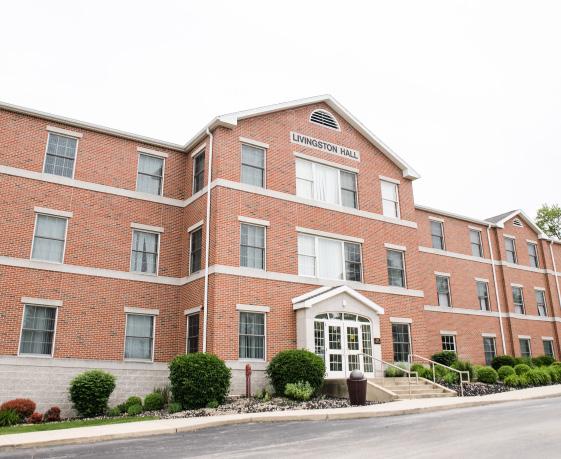
The major construction project of the late 1940s was Wright Memorial Hall. Built as a memorial to “the young men of the college who served in the armed forces and to those who sacrificed their lives during World War II,” the residence hall also honored the memory of Bishop Milton Wright. The first Wright Hall, finished at a cost of around $200,000 in 1949, remained until the 1980s, when Roush Hall was built in its place.
The new Wright Hall, finished in 1987, was part of President Habecker’s Long Range Plan. Fittingly, Bishop Wright, a man who was instrumental in the
founding of Central College, would lend his name to a key piece of our further development 90 years later.
In 1997, Huntington College awarded a Centennial Medallion to Bishop Wright posthumously. His great-grandson, the late Wick Wright, accepted the medallion on his behalf. During the ceremony, Wright presented a swatch of cloth from the left wing of the Wright brothers’ original aircraft to HC. Since then, the swatch has been on display in the Wright Hall lobby.
Concerts and recitals historically took place in Davis Hall. The first fullscale dramatic production was Shakespeare’s As You Like It, directed by Nellie Binning, head of the School of Oratory and future wife of President Bangs. The cast included Dr. Fred Loew and Harold “Harry” Mason, future college president.
Decades later, Dr. Carl Zurcher still staged plays in Davis Hall during his time as theatre director. Davis Hall productions faced limited resources and a small stage. The completion of the MCA in 1990 exponentially expanded opportunities for theatre, music and visual art production at Huntington College.
“The Follies” started as an annual Davis Hall event sponsored by the women of Livingston Hall. When the MCA was built, Livingston was no longer a residence hall, and when the follies transferred to Zurcher Auditorium they became the Davis Hall Follies.
Around 1909, we divided Davis Hall and installed a basketball court on a portion of the floor. The Philomathean and Zetalethean Literary Societies used two rooms at one end of the auditorium.
As enrollment grew, chapel services moved upstairs from the main floor to Davis Hall. Chapel services in Davis Hall were strictly regulated, with assigned seats, mandatory attendance and supervision to make sure no foolishness or unruly behavior occurred. Evidence also suggests that

Davis Hall originally encompassed the entire third floor of College Hall (now Becker Hall). Since then, the space has changed as Foresters had need. The Merillat Centre for the Arts (MCA) now fulfills many of Davis Hall’s previous uses as a place for performances, chapel services and graduations.
students took a strong interest in chapel. In the 1940s, students organized a volunteer labor force to raise money for an organ. They called it “Organ-ized Labor.” It was a successful campaign and resulted in the purchase of an electronic organ for chapel use.
By the 1970s, the student body outgrew the seating capacity of Davis Hall, and chapels moved to College Park UB Church. Today, students attend community chapel services in the MCA, primarily in Zurcher Auditorium.
For our first graduating classes, Commencement took place in Davis Hall. The first graduation ceremony began at 10:00 a.m. on June 14, 1899, and included orations from the three graduates.
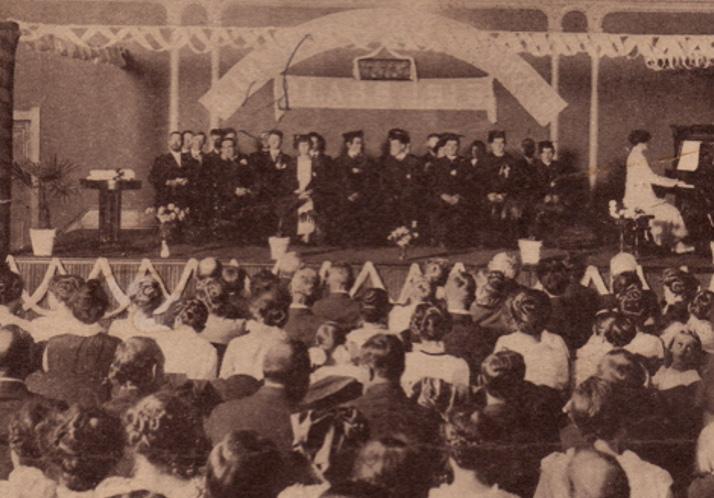

Since 2020, Commencement ceremonies for HU’s Indiana locations have taken place in Zurcher Auditorium in the MCA. There are multiple ceremonies for our spring Commencement, allowing us to make full use of the MCA’s air conditioning and comfortable seating.
During World War I, the Student Army Training Corp, a national government program, took up residence in College Hall. Some of the men who bunked there used Davis Hall as their barracks.
The MCA, on the other hand, has never been a sanctioned sleeping space.
One spring day in 1942, employees arrived at the Ad Building for work and heard mooing from above. They discovered that there was a cow in Davis Hall. During the night, senior fellows had coaxed a cow up three flights of stairs and deposited it in the hall with some hay. Getting the cow to go back down the stairs, however, proved difficult. Let’s just say it was a huge mess that the senior men were forced to clean up. Unfortunately, no known photos exist of this event.
As a UB bishop from 1838-1860, Lewis Davis pushed to create UB institutions for learning. To dedicate a hall after Dr. Lewis was an homage to the man who spurred on the education of the United Brethren Church.
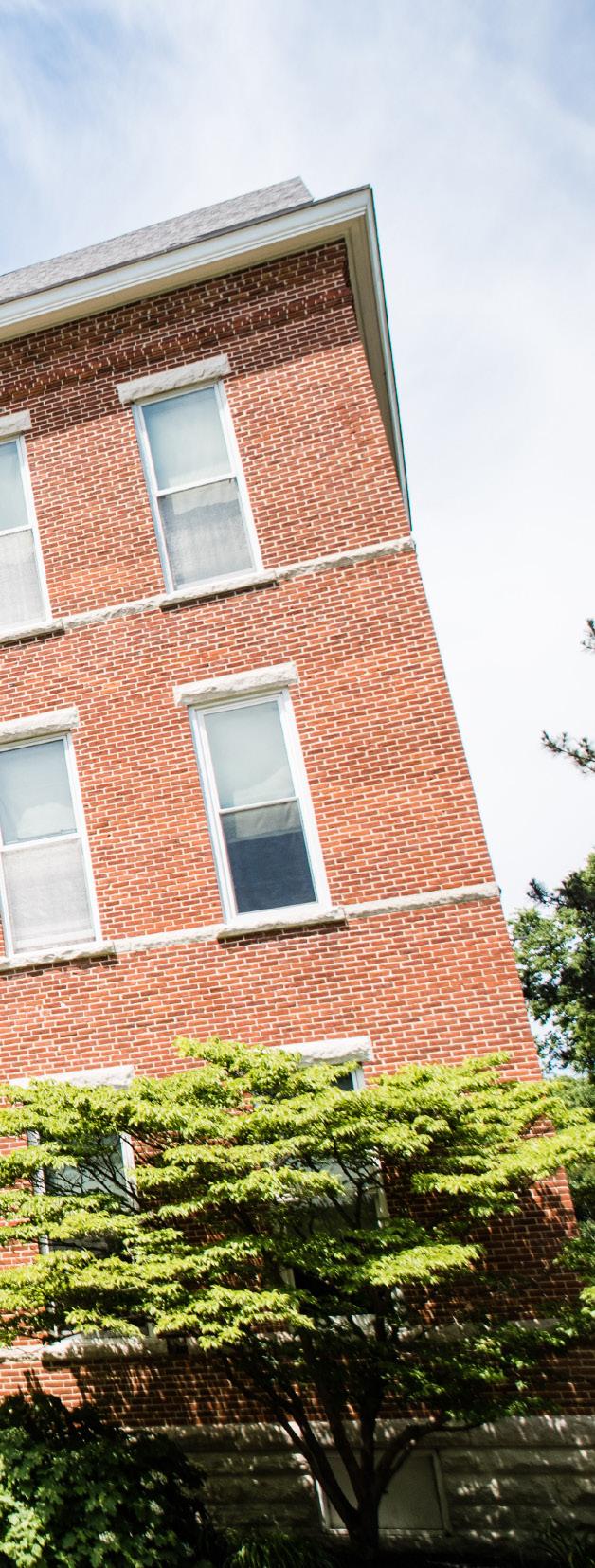
Huntington University has gone by three names in the past 125 YEARS . While this makes writing about our history interesting (note the number of “now known as” statements in this magazine alone), the truth is that these name changes reflect our growth in a powerful way. With added students, employees, locations and programs, Huntington University today is a more mature version of who we were as Central College in 1897. Our core identity has remained constant, but these names also represent what we have become.

There were great expectations for the future of Central College. In addition to setting aside land for a building (Becker Hall), the Huntington Land Association and the United Brethren Church sold lots for homes in what became College Park. Charles Kiracofe, our first president, enthusiastically sold UB lots for $270 each. He also platted out the lots and the general layout of streets.
Kiracofe encouraged purchasers to start building immediately so that students and professors would have housing. Many students lived with area families until we had permanent residence halls much later. It was not unusual for whole families to purchase lots and build houses in the College Park area just so their son or daughter could be educated at Central College.
At the turn of the century, the College was a distant addition to the town of Huntington. A dirt road renamed College Avenue became the main link to the rest of the city about a mile distant. A wooden sidewalk, which lasted about ten years, was provided from the College Park addition.
Our name change from Central College to Huntington College was long anticipated. Before 1916, the local newspapers were using the two names interchangeably. One of President Bangs’ goals was a closer relationship between the Huntington community and the College.
President Bangs began the process of an institutional name change in spring 1916. On June 26, the Board of Education agreed to Bangs’ proposal and voted to recommend the change at the next General Conference.
Unfortunately, the General Conference did not meet for another year. On May 15, 1917, after five days of meetings, the General Conference referred the matter to the committee on education. It did not take long for the report to come back to the full conference, and on May 16, 1917, President Bangs was asked to speak to the proposal.
All was going well until Bishop and former Central College President Fermin Hoskins objected to the item in the report that called for the name change. Nevertheless, the full report was passed by an overwhelming majority. Central College became Huntington College.

“This move reflects what we have already become and what we yet will be,” said President Dowden on October 15, 2004, at the Board of Trustees meeting. The Board voted that day to move to university status. Our name officially changed from Huntington College to Huntington University in time for the 2005-2006 academic year.
Informal discussions about becoming a university had begun as early as the 1980s; a task force considered the move in 1995 but concluded there was no compelling reason to change at that time. Ten years later, the world of higher education had shifted, and a new task force recommended that we pursue university status.
More than anything, the change spoke to our longstanding reputation of academic excellence. Neither the State of Indiana nor our accrediting commission had rules for who may use the name college or university, but university status brought with it a perception of quality, prestige and diverse programming. Our goal was to retain the close-knit community and Christ-centered traditions that characterized Huntington College.
As University Status Task Force chair Dr. Jerry Smith said in a Huntington College Magazine article about the change, “the name is less important than the mission, and our purpose continues to be to provide Christ-centered education. We must say again and again that we are a Christian liberal-arts university, just as in the past, we have emphasized that we have been a Christian liberal-arts college.”

Bangs joined the faculty at age 22. At 25, he became the youngest president of any accredited college. His accomplishments seemed endless, including our name
Kiracofe was a key player in bringing Central College into existence. The home he built for himself would even become the first Livingston Hall years later.
McMurray was only 26 when he joined the Central College faculty. Athletic and personable, he was very well liked. As president, he developed the Normal School, which trained teachers.
Ellabarger’s abilities as an educator and administrator served his presidency well, leading to an increase in enrollment. His daughter, Leora Ellabarger Stoudt (1921), penned the Alma Mater.







At the beginning of the Great Depression, many faculty went without pay and received room and board only. By 1932, Mummart felt we needed to pause our operation. The Board of Education agreed to a temporary closure.
Habecker began at HC as an executive vice president developing a Long Range Plan. His presidency included 19 new buildings and a $32 million increase in college assets, among many other achievements.
Dowden’s presidency included substantial program growth. In his first ten years, we saw a 73 percent enrollment increase. He also oversaw our name change from Huntington College to Huntington University.
Whether they served for one year or 24 years, these individuals brought their unique talents, vison and leadership to their presidencies and helped shape what Huntington University would become.Clare W. H. Bangs (1915-1919) Charles H. Kiracofe (1897-1902) James H. McMurray (1902-1905) Daniel Ellabarger (1919-1925) Clarence A. Mummart (1925-1932) Eugene B. Habecker (1981-1991) G. Blair Dowden (1991-2013)
An editorial in The Christian Conservator at the time of Gragg’s death remarked, “Student perplexities in those days were no less real than in the present time. It was second nature with the president to help in these perplexities.”
Hoskins had a brilliant intellect, and his personal library was said to be one of the largest in the Northwest, bigger than Central College’s. He resigned after only one year in office to return to the West.

Mummart was the first Central College graduate to be president. During his first year in office, he erased the college debt and personally recruited students.
After two months of closure, the Board hired alumnus Mason as president and reopened. Mason brought a new vigor to his role. By the time he left in 1939, the value of the college had doubled. For two years after Mason resigned, we were without a president.
The culminating event of Becker’s administration was our accreditation from the North Central Association after much effort. Becker also had the longest tenure







HC alumnus Baker’s presidency included a nearly 600 percent increase in our net worth and the construction of Hardy Hall, the founding of the Graduate School of
Emberton is the first woman to fill this role at HU. Her tenure includes the completion of our largest comprehensive campaign, leading to the development of new programs, expansion to four locations and record enrollment.
Thomas H. Gragg (1906-1911) Fermin L. Hoskins (1911-1912) Clarence A. Mummart (1912-1915) Harold C. Mason (1932-1939) Elmer Becker (1941-1965) E. Dewitt Baker (1965-1981) Sherilyn R. Emberton (2013-present)September 21, 1897
Central College is dedicated and classes start the next day
June 1899
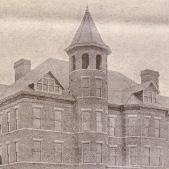
The first class, including Rufus A. Morrison, J. W. Sell, and Elizabeth Zehring, graduates.

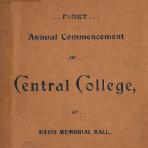
1920
The first Washington Banquet is held.
1969
The Huntington College Archives are established.
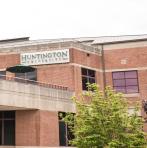
Miss E. Faye Conner, a former librarian, is the first to occupy the position.

1967
The Indiana Beta chapter of Alpha Chi, a national honor society, is inaugurated.
1961
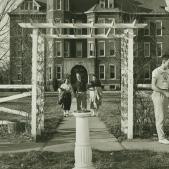
Accreditation is received from the North Central Association.
1972
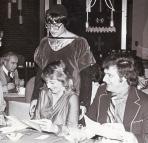
The Graduate School of Christian Ministries is established, replacing the Theological Seminary that had been in existence since the beginning of the institution. Dr. Paul Fetters will lead the Graduate School of Christian Ministries for much of its existence.

2001
Fall enrollment tops 1,000 students.

2014
The Doctoral Program in Occupational Therapy accepts its inaugural cohort at the Fort Wayne location.
These events from our history have marked our growth from a single brick structure to four locations and over 1,400 students.
1928
The Foresters are named for the first time. Local sports writer “Cash” Keller, while watching a Huntington College basketball game, remarked that the team reminded him of the famed Robin Hood and his green-clad Foresters.
1932
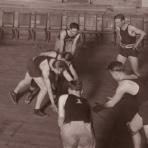
The first Student Union is organized. Isaac H. Osgood is the first student body president.

1921

1937
The first Garden Day is held.
1935
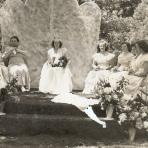

The Fred Loew Botanical Garden and Arboretum is established to the north of College Hall and dedicated in 1937.
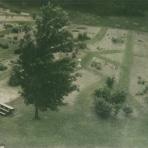
1949
Our first “official” Homecoming.
2020
UB Launch, an enterprise of HU, opens in downtown Huntington.
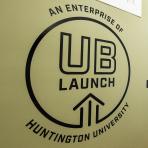
August 2016
Huntington University Arizona students attend classes in the Center for Digital Media Arts in Peoria, Arizona, for the first time.
2021
The Doctoral Program in Occupational Therapy welcomes its first HU Arizona cohort.
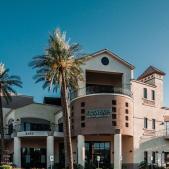
 Leora Ellabarger Stoudt composes the Alma Mater.
Leora Ellabarger Stoudt composes the Alma Mater.

We have been collecting alumni stories for well over a century. To celebrate 125 YEARS of Christ, scholarship and service at HU, we are bringing out some of our favorites. These stories are hardly representative of the entire depth and breadth of the Forester experience. Rather, they highlight moments of our shared history through the lens of people who were there. The following stories come from our archives, alumnisubmitted content and fresh reporting.
1899 Elizabeth Zehring Weaver was a member of the first graduating class.
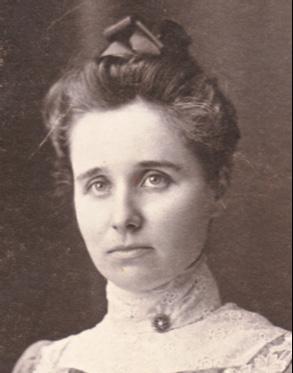
Elizabeth Weaver, a teacher and philanthropist, earned what we would now call a Bachelor of Arts degree. From Brookville, Ohio, she spent most of her career in the vicinity teaching at various Montgomery County schools. She and her husband, Elgar Weaver, donated close to a million dollars to Wittenberg College for a chapel and observatory and were members of the Lutheran church.
1915 Stanton Lautenschlager was a minister and teacher in China for more than twenty years.
Canada-born Stanton Lautenschlager arrived in China in 1920. As part of his missionary service, he was a professor of modern history at Cheeloo University. He also preached in Chinese high schools, and it is estimated that over 6,000 students made decisions for Christ. With the outbreak of the Second Sino-Japanese War, he continued to preach in both Free China and the Communist-held parts of the country, returning to the United States in 1941.

1924
Mildred M. Osgood Levor
was a puppet artist and pioneer filmmaker.
Mildred Levor entertained children during World War II air raid drills with shadow puppets. The shadow puppets’ light and airy movements caught her attention, and she experimented with techniques to produce lighter, more flexible puppets from unusual materials. In 1949, she patented the technique she would use and teach the rest of her life. Her puppets could be filmed in action for longer scenes than traditional puppets, which required stop motion photography.
1931 Irene Bergdall influenced generations of Foresters.
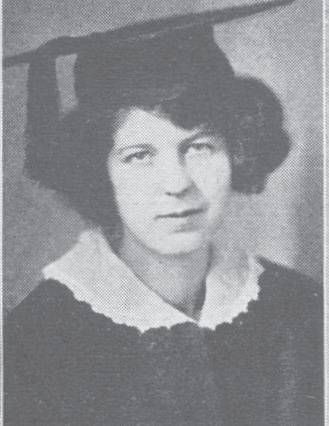

Dr. Irene Bergdall served as the dean of women and associate professor of mathematics for more than three decades. Her window faced the front of Livingston Hall, carefully but graciously watching over the hall’s residents — and anyone who tried to break curfew. In his eulogy for Bergdall in 1996, her colleague and neighbor Paul Fetters remarked, “In her guilelessness and sincerity, Irene influenced others by pure grace. This is the virtue I admired most about Irene.”

Lawrence Meriwether
was a singing evangelist and musical soloist.
Lawrence Meriwether was an elementary school teacher immediately after graduating from high school. Thirteen years later, he enrolled at Huntington College at the age of 42. His eyesight was failing, so he worked with someone who would read to him. While pursuing a degree in voice, he was the College quartet coach and a voice teacher. After graduation, he worked as a soloist in religious and secular settings, caned chairs, pursued a master’s degree in English, and more.
1957
Nilla Barnard Vallo was dedicated to creating high-quality education opportunities.
Originally from Ohio, Dr. Nilla Vallo moved to the Southwest in the 1950s to teach on a Native American reservation. Her career in education included time on New Mexico’s Child Development Board. She was a mentor for young teachers, an advocate for bilingual teaching and native-cultural literacy and an administrator of early education programs. Vallo and her husband helped establish LORE, Inc. (Learning Opens Roads for Excellence), a nonprofit to improve cultural education opportunities for Native Americans.
1969
tied or broke six HC soccer records.
After graduating from Huntington College, Dr. Pat Zezula remained as an instructor, assistant athletic director and coach. At various times during her first 15 years on staff, she assumed head-coaching responsibilities of every women’s sport offered. In 1982, she was promoted to athletic director, giving her the distinction of becoming the first female intercollegiate athletic director in Indiana. She retired in 2006 after a 37-year tenure at HC.
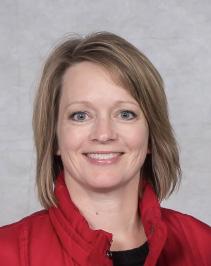
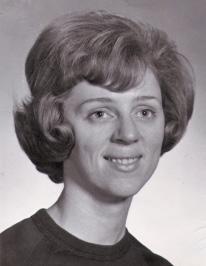
1971
Jack
Dr. Jack E. Daniels III was appointed eighth president of Madison College in 2013. His career in higher education has also included seven years as president of the Los Angeles Southwest College, three years as president of Lincoln Land Community College, five years as president of Houston Community College System’s Central College, a tenured psychology faculty position and several other administrative roles.
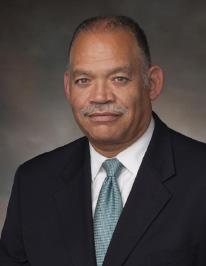
Alumni-submitted content
Huntington College retired John “Buddy” Labor’s soccer jersey number, 10, on February 23, 1988, weeks before Labor graduated. During his Forester soccer career, Labor tied or broke six HC records, including most goals scored in a career (100) and was among the leaders of the 1986 team that placed fourth overall in the NCCAA. He also ranked among the top 10 scorers in the NCCAA.
1995 Jennifer Hotchkiss helped create Olympiad.
Jennifer Hotchkiss changed majors from elementary education to recreation management after meeting with Professor Connie Updike. This meant that she was a part of creating for one of Updike’s classes what has become an ongoing HU tradition. As Hotchkiss later remarked, “One project that our class was responsible for was starting a fun weekend with a bunch of different on-campus activities for the students. We decided to name it The Olympiad.”
Alumni-submitted content

Pat Zezula was the first female intercollegiate athletic director in Indiana.
E. Daniels III is a college president.
Brandon Holler earned a degree in biology before becoming a pastor.

Brandon Holler attended HC to play basketball and become a doctor, but an experience leading a seventh-grader to Christ changed his career path. He said that he graduated with “a desire to give my life to God no matter what he had me do. I had little to no relationship with Christ when I was a freshman, but by the time I was a senior, I wanted Jesus to be the focal point of everything I did.”
Alumni-submitted content
went from being a social work student to chair of the department in just over a decade.
Dr. Samantha Sutorius felt God calling her to social work after taking the Intro to Social Work class at HU. She was a member of one of our first social work graduating classes. After working in the field for several years, she returned to HU in 2016 to teach in the very department that got her started. By 2021, she had earned her Doctor of Social Work degree and become department chair.
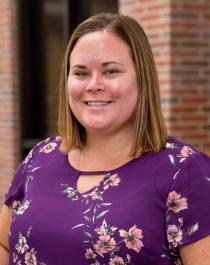
Alumni-submitted content

Ericka Whitman was the first Forester MVP of the Overwatch finals.
Ericka Whitman, or Doxic as she is known in the realm of esports, was a member of the inaugural Huntington University Esports Overwatch team in spring 2022. The team splashed onto the scene to be deemed the Navigators Division: National Runner-Up at the NECC National Tournament. Whitman distinguished herself by being named MVP (a commentator designation) at the Grand Finals stage of competition, the first Forester player ever named MVP at that level.

Huntington University is pleased and humbled to announce that the Step Forward Comprehensive Campaign launched in the fall of 2014 has shattered all campaign goals and raised a total of $56,623,840. This is $22 million more than the original campaign goal, and it is the largest campaign in University history.
In 2014, the Huntington University Board of Trustees approved a comprehensive campaign of $34 million.
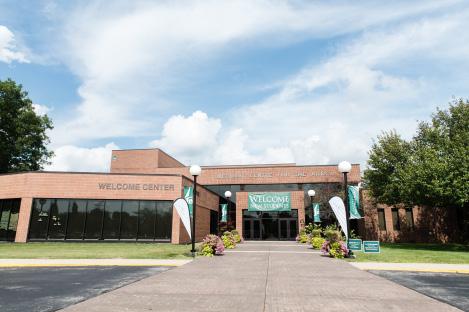
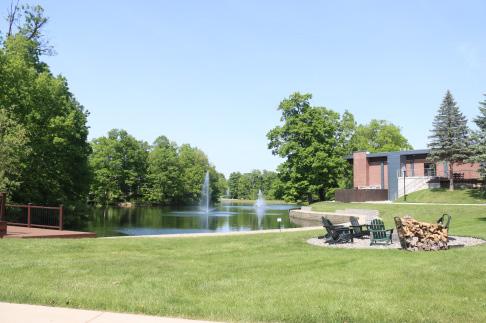
2,281 donors
“For those of us in the room when that was decided, that was a large goal and, frankly, a pretty daunting one,” said Tom Clounie, Advancement Committee chair. “And it had a ticking clock on it. We knew this campaign was intended to wrap up in 2022 as part of the University’s 125th birthday year.”
through fiscal year 2020-2021
That $34 million figure included six capital projects and nine new academic program launches in addition to growing the endowment and scholarship funds. Prior to taking the campaign public, the campaign had already funded the 2015 renovations to Forest Glen Park, the 2016 construction of the new Welcome Center and the 2017 completion of the Ware Plant Science Production Facility, but that was only the beginning.
“Seeing the faithfulness of God in this campaign and the success of the campaign to date, in the fall of 2019, on the recommendation of the Board of Trustees, the Step Forward Campaign goal was increased to $40 million,” said Clounie.
The Forester Fund reached $4.3 million surpassing the $4.2 million goal for student scholarships
increased by
The endowment increased by
50%
50%
($12.5 million)
($12.5 million)
$5.8 million in new contributions
The increased by $5.8 million in new contributions $6.7 million market gains
$5.8 million in new contributions $6.7 million in market gains
Fast forward to today and the campaign results.
Since the fall of 2014, Huntington University has invested more than the projected $7.9 million in capital projects, including (but not limited to)
• New occupational therapy labs
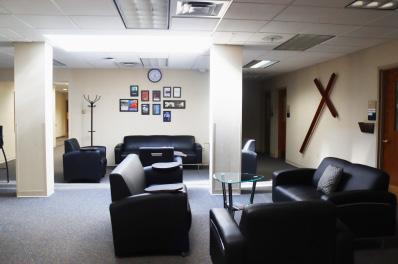

Data through April 30, 2022
• Renovations at HU Arizona to create space for an entire OTD program location
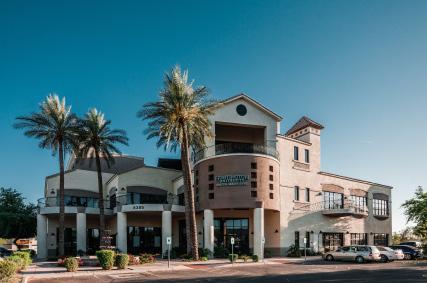
• The reconfiguration of the Nursing Lab in Dowden Science Hall
• The Forest Glen renovations and new turf project
• The reimagination of the student center (known as the HUB)
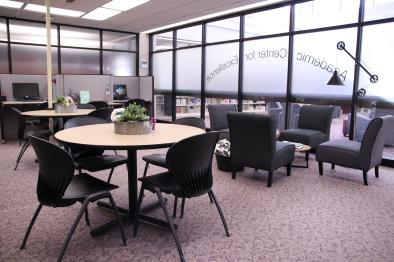

• The construction of the Welcome Center as part of the Merillat Centre for the Arts
• The Ware Plant Science Production Facility addition to Dowden Science Hall
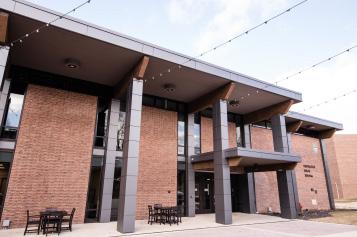
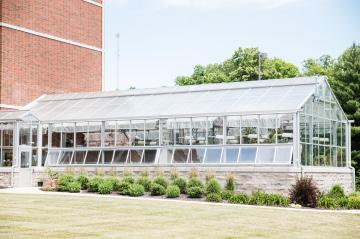
• The construction of the Don Strauss Animal Science Education Center
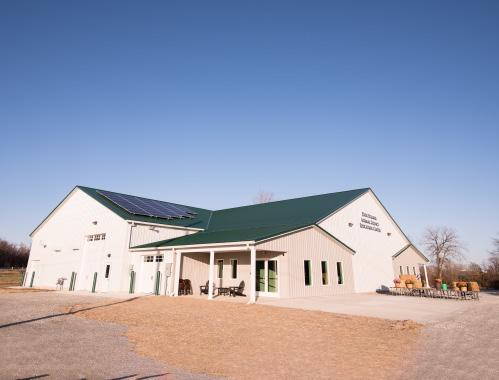
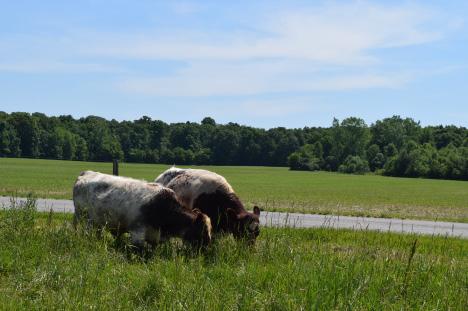
• The creation of the esports competition lab
• The updates to the sand volleyball court and construction of the pavilion

• The UB Launch renovation


9 gifts of a million dollars or more
As a comprehensive campaign, Step Forward surpassed additional campaign goals. Below are some key examples.
gifts of a dollars or
9 gifts of a million dollars or more donors on average per year
Total enrollment increased by 6.37% contributions
Total enrollment contributions
2,281 donors on average per year donors became Pacese er Society members
• $5.8 million has been added to the University endowment. That’s over $1.8 million more than the goal. And the overall endowment during the campaign years (2014-2022) has increased by 50%.
Total enrollment increased by through
◦ The Bachelor of Science degree in engineering
◦ The Master of Business Administration degree
• Nearly $1.2 million has been invested in academic upgrades and improvements, including












through 2020-2021
• $4.3 million has been raised toward the Forester Fund, HU’s student scholarship fund, which provides financial assistance for over 90% of the University’s traditional undergraduate students; every single dollar raised for that Fund goes directly toward student scholarships
through fiscal year 2020-2021
through fiscal year 2020-2021
The Forester Fund reached $4.3 million surpassing the $4.2 million goal for student scholarships
Pacese er Society members surpassing the $4.2 million goal for student scholarships
2,281 on donors er Society members Forester Fund surpassing $4.2 million


• $4.8 million has been invested in personnel and employee compensation
Data through April 30, 2022
• $3.8 million has been invested in launching five new academic programs, including


◦ The Doctoral Program in Occupational Therapy — one of the first in the country
◦ The Bachelor of Science degree in occupational therapy assistant — the first in the country
• Overall enrollment has increased by 12.7%


• 396 Foresters have graduated from HU thanks directly to Step Forward Campaign programs
◦ 12 degree specializations in agriculture
◦ Additional academic classroom resources ($250K)
◦ Anatomage Tables ($300K)
◦ Agriculture equipment ($400K)


◦ Technology ($200K)
“The results of this campaign allow HU to move forward faster to accomplish the mission God has called us to do,” said Dr. Sherilyn Emberton, president of Huntington University. “God’s faithfulness to the University through challenging times and a global pandemic is beyond evident in this campaign, not only in the capital projects completed and the dollars raised, but more importantly in the lives impacted. Nearly 400 additional graduates earned HU degrees as a direct result of this campaign. That’s a powerful statement to the steps of faith taken by so many since 2014.”
Our 125TH CELEBRATION in 2022 officially began when Dr. Tony Evans visited home campus in March as a guest speaker. We continued the celebration with community parades and festivals, a Mini Museum of Historical Memories and 125 Fest, a home campus party for students and employees complete with a zip line, a hog roast and a fondant replica of Becker Hall.

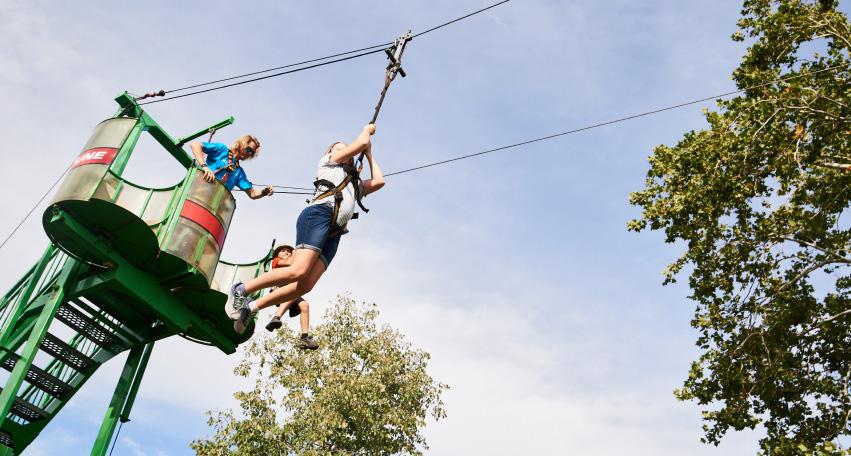


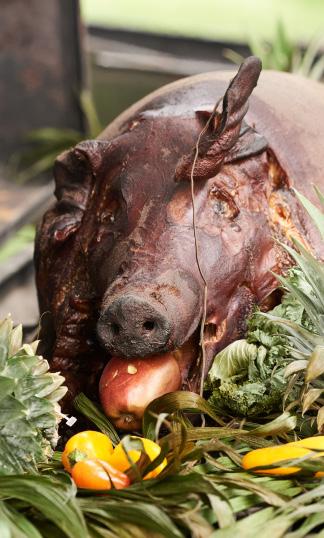
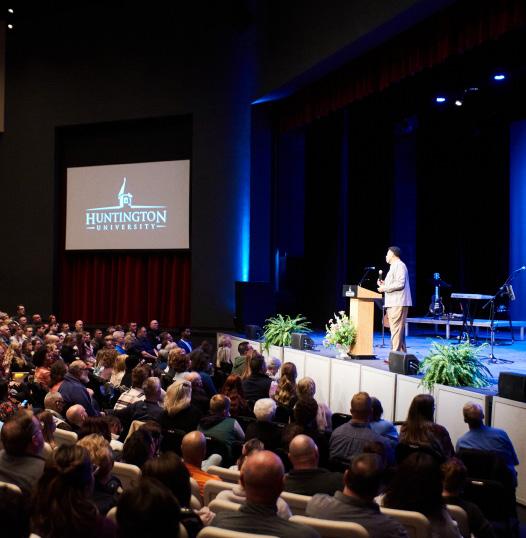


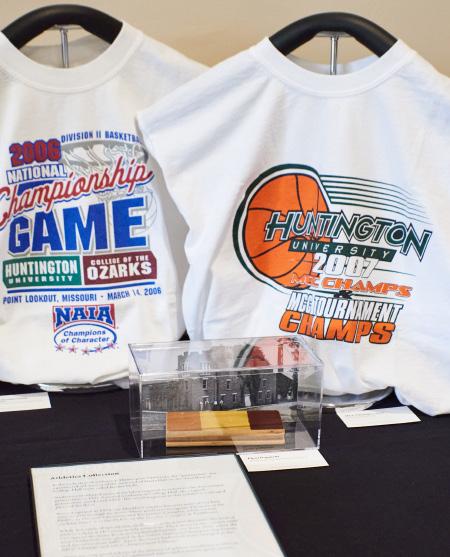

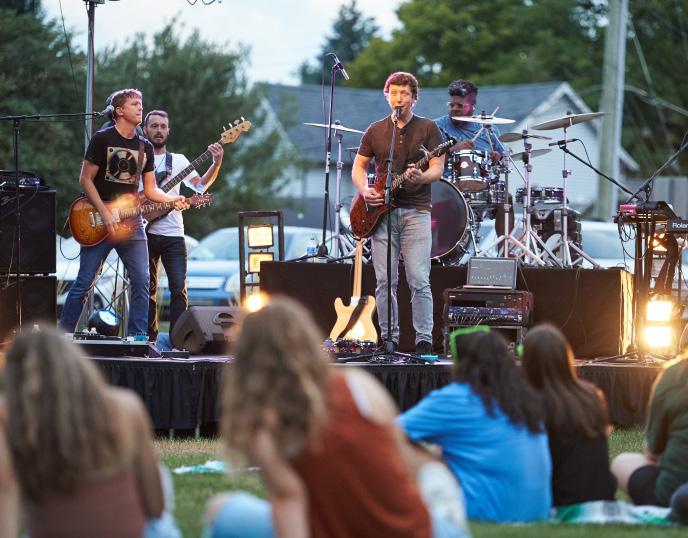

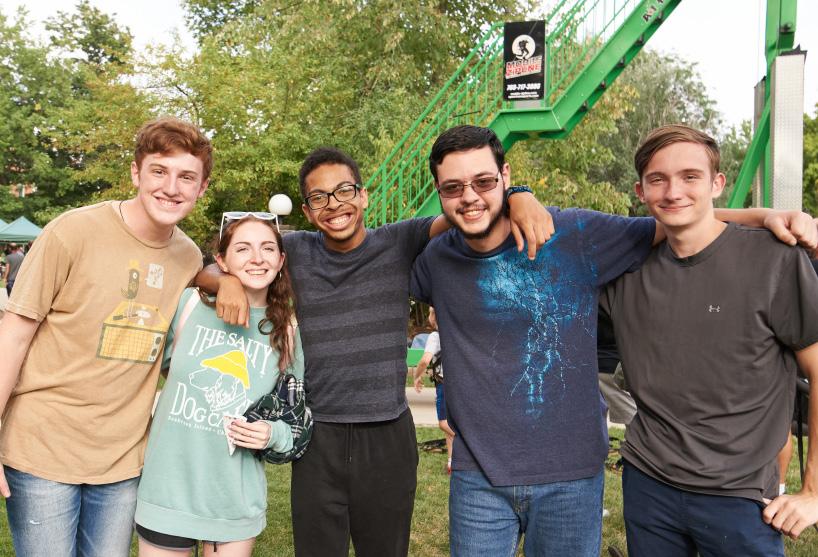
For 125 years, Huntington University has offered men and women an education built upon the foundation of Christ, scholarship, and service. Thousands of Foresters have entered HU with a vision and have graduated with renewed conviction and powerful purpose. The roots of HU continue to grow deeper, our Forest of Foresters continues to flourish, and we look toward the future and what God has in store.
This was the foundation for Forever Foresters.
This strategic plan, following on the heels of the successful Step Forward Comprehensive Campaign and Faith Forward Strategic Plan, will propel Huntington University toward 2023 with success and growth.
Throughout the decades, the University has established new programs, added new faculty and staff positions and imagined creative spaces for new buildings with unique features. The University has grown from a single building (now known as Becker Hall) to 18 buildings on home campus, a 30,000-square-foot building in Arizona, a multi-level facility in Fort Wayne, and a co-working space for innovation and entrepreneurship in downtown Huntington. Students can now pursue bachelor’s, master’s
and doctoral degree programs, mix and match online and face-to-face modalities, study programs in different locations and participate in 17 different athletic sports (and counting). Clearly, Huntington University has flourished...and we’re just getting started.
Forever Foresters is a five-year strategic plan focused on five key pillars:
Pillar 1
Strengthening student engagement and belonging
Pillar 2
Enhancing a culture of academic excellence
Pillar 3
Sustaining spiritual significance and faithful service
Pillar 4
Promoting enrollment growth, strategic programs, and visibility
Pillar 5
Increasing student economic value and institutional financial strength
Since 1897, each generation of Foresters has laid a foundation of excellence on which the next generation can flourish. Often, that process has included a refining of academic majors, researching of new teaching methods and innovative technologies and adding of new labs and equipment to better prepare students for emerging careers and exciting new ministry fields.
The pillars of this strategic document center on foundational strengths of Huntington University — ones that continue to be refined for the glory of God. In Isaiah 28:16, God reminds us of the importance of honoring foundation:
Success of these initiatives will manifest in a greater understanding of what it means to be a Forester — a sense of purpose, calling and belonging. Programs identified for future growth or reinvestment require an understanding of the role of academic excellence and graduate success, and our ability to advance our mission rests on the financial resiliency of our stewardship of the resources provided. However, our true sense of accomplishment rests in the spiritual growth of our students and the communities we serve.
May we always be found as Forever Faithful
May our hearts always be joined as Forever Family.
May we never forget that we are Forever Foresters!
“Therefore thus says the Lord God, ‘Behold, I am the one who has laid as a foundation in Zion, a stone, a tested stone, a precious cornerstone, of a sure foundation...’”
Developed in 2019 and adopted in 2020, the Spirit of a Forester is the result of countless conversations with innumerable Huntington University alumni. At its core, it is a set of traits reflecting what alumni have been saying about HU all along, even before we received the name Foresters in 1928. The Spirit of a Forester is a heartfelt answer to one unexpectedly complex question:
The simple answer is that a Forester is a Huntington University student. Any student at any location and any age. But the truer answer is this.
• CHASES TRUTH. Because all truth is God’s truth, Foresters relentlessly pursue it. They seek to glorify their Creator by caring for every tree, stone and being in His creation and to be “ministers of reconciliation” (2 Cor. 5:18) who see creation’s redemptive potential. (John 8:32)
• DEFIES COMPLACENCY. Foresters never stop trying to improve themselves or the world around them. Failures will happen, but Foresters will use mistakes as growth opportunities. (Romans 8:28)
• REMAINS CURIOUS. College is a fundamental time in education, but a Forester will seek new opportunities to learn long after graduation. (Proverbs 4:6-7)
• CARES COMPLETELY. Foresters are dedicated to service, caring for others both willingly and joyfully. They also care about forming relationships within the Forester Nation and
nurturing new generations of Foresters. As foresters care for plants in every stage of the life cycle, from seedling to mature tree to acorn, so Foresters get involved in others’ growth through prayer, interpersonal relationships and giving back to the University. (Romans 12:10)
• EMBRACES INTERCONNECTEDNESS. In a forest, tree roots intertwine and make the ground stronger. Foresters realize that any pursuit – art, literature, math, science, history, etc. – is stronger in community. A Forester seeks experiences across disciplines and with others, and that interconnectedness becomes a Forester’s strength. (John 15:5)
• HAS GRIT. Like a forester in the wood contending with dirt and branches and leaves, a Forester doesn’t back down from making a difference just because it’s going to get messy. Foresters answer the call to serve. (Isaiah 41:10)
• EXPLORES CREATIVITY. Foresters push the boundaries of their art. Not every Forester wields a paint brush or camera, but all Foresters seek innovations, new perspectives and inventive solutions that propel their disciplines forward. (Colossians 3:23-24)
Together, these traits come together to point others toward Christ.
A Forester’s status doesn’t end at graduation; it’s a lifetime appointment. Once you become a Forester, you are a Forester forever. In practical terms, this means that the knowledge you have gained, the skills you have learned and the people you have met through Huntington University will impact your daily life and shape the course of your future. This also means that everywhere you go, you are an embodiment of the Forester spirit.
With fluctuations in the market, many people are searching for alternative ways to receive secure income for themselves and their families. A charitable gift annuity provides the opportunity to receive lifetime income while enjoying significant tax benefits. This tax-wise form of planning is also an investment in Huntington University students as they advance their education and seek to impact the world for Christ.
The benefits of a charitable gift annuity with HU include
• Guaranteed fixed income for life, part of which is tax free
• Income tax savings when itemizing deductions on tax return
• Capital gains tax benefits upon transfer of appreciated stock
In return for your gift of cash or appreciated stock, the University agrees to pay you, or you and a loved one, income for life. Each payment is a fixed amount, and payout rates are based on age. After you receive income for life, the remaining funds are used to the benefit the University for the purpose you designate.
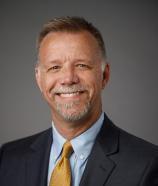
Spring Semester Starts
January 9
Day of Giving
March 16
Spring Commencement (Indiana)
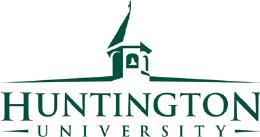
April 29
Spring Commencement (Arizona)
May 5
Summer Commencement
August 12
Homecoming October 6-7